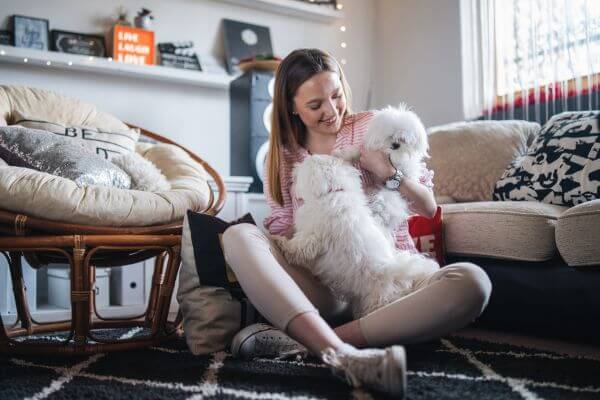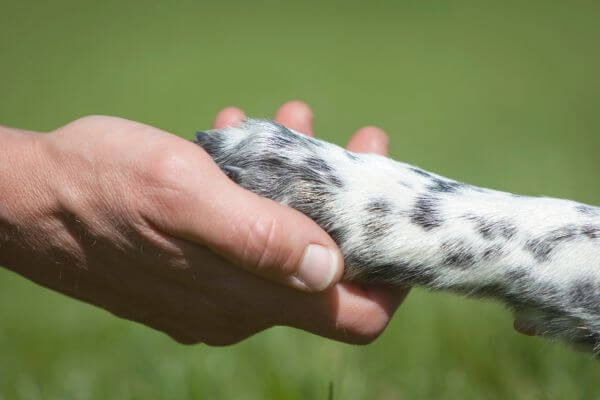Understanding how communication between pets is essential to strengthening the bond with our furry friends. Let’s explore the secrets behind this unique language and how it influences dog training.
The Importance of Animal Communication

Communication between pets goes far beyond barking and meowing. Every movement, expression and behavior carries meanings that shape your interaction with us.
In creating a harmonious environment, understanding this language is essential to establishing a relationship of trust and respect with our four-legged companions.
Through close observation, we can decipher the signals our animals send us. From body language to different tones of vocalization, each gesture tells a story about your needs and emotions.
The use of positive reinforcement in dog training aligns perfectly with this approach. By understanding how dogs communicate, we can target their behavior effectively, promoting learning through positive stimuli and rewards.
Communication between humans and animals is a two-way street. By learning our pets’ language, we also become better guardians, capable of meeting their needs in a more empathetic and efficient way.
Strategies to Improve Communication
Understanding communication between pets requires specific techniques to strengthen the bond between owners and their furry companions.
By adopting an approach based on positive reinforcement, we can establish effective communication with our dogs. Using rewards, such as snacks or praise, reinforces desired behaviors and strengthens the trust relationship.
Furthermore, using clear and consistent body language is essential to convey our intentions to our pets. Simple gestures, such as crouching down to call the dog or extending your hand to greet, help establish clear and unambiguous communication.
Investing time in training and socialization is also essential to improving communication between humans and dogs. Exposure to different stimuli and situations helps dogs develop social skills and better understand our signals and commands.
The Importance of Mutual Respect

For effective communication between humans and pets, it is essential to establish a relationship based on mutual respect and understanding the needs of both parties.
Respect for the individuality of each animal is essential to build solid communication. Each pet has its own personality and preferences, and it is important to recognize and respect these differences.
Furthermore, we must be aware of our pet’s limits and avoid imposing our will in an authoritarian way. Effective communication is based on trust and mutual understanding, and this is only possible when we treat our pets with respect and empathy.
By establishing a partnership relationship with our animals, we can build communication based on trust and collaboration. Respecting our pet’s needs and limits is essential to strengthening the bond and ensuring a harmonious coexistence.
Overcoming Communication Barriers
Although communication between humans and pets is incredibly rich, sometimes challenges can arise that make it difficult to understand each other.
Factors such as past trauma, lack of socialization or even health problems can affect our pet’s ability to communicate. It is important to be aware of these signs and seek professional help when necessary.
Patience and persistence are essential to overcome these barriers in communication. Investing time and effort in training and socializing your pet can help strengthen bonds and improve communication between you.
Always remember that human-pet communication is an ongoing journey. Be open to learning and willing to adapt your strategies according to your pet’s needs, and together you will be able to build an even stronger and more meaningful relationship.
The Importance of Non-Verbal Communication
In the relationship between humans and pets, nonverbal communication plays a crucial role in conveying emotions and intentions.
Dogs, in particular, are masters at reading human body language. They are able to capture subtle nuances in our gestures and facial expressions, which contributes to more effective and intuitive communication.
By learning to interpret your dog’s body language, you will be able to establish deeper, more meaningful communication with your dog. Simple gestures like stroking the head or making gentle eye contact can convey love, support, and trust.
Therefore, when interacting with your pet, remember to pay attention not only to the words you say, but also to the nonverbal signals you are sending. Consistent, authentic communication is key to strengthening the bond between you and your pet.
The Role of Empathy in Communication
Empathy plays a fundamental role in communication between humans and pets, allowing us to understand and respond to our pet’s emotional needs.
Putting yourself in your pet’s shoes and trying to see the world through their eyes is essential to establishing effective communication. This allows us to recognize your emotions, understand your concerns and respond appropriately.
By demonstrating empathy in our interactions with our pets, we are strengthening the bond of trust and creating a supportive and safe environment for them. This, in turn, facilitates communication and promotes a more harmonious and satisfying relationship.
So when interacting with your pet, remember to be sensitive to their emotional needs and be there to offer support and comfort whenever needed. Communication based on empathy is the key to building a lasting and meaningful relationship with your pet.
The Evolution of Communication between Humans and Animals
Throughout history, communication between humans and pets has undergone significant evolution, shaped by our increasing understanding of the animal world and the development of more humane training techniques.
Since the dawn of domestication, humans have sought to establish a deeper connection with the animals around them. Initially, this manifested itself mainly through the use of basic commands and the imposition of authority.
However, as our understanding of animal behavior has advanced, so have our training techniques. Today, we prioritize approaches based on positive reinforcement and non-verbal communication, which promote a relationship of partnership and mutual respect.
This ongoing evolution of human-animal communication reflects not only our growing understanding of the animal world, but also our ability to adapt and learn from our four-legged friends. As we continue to improve our communication techniques, we can build stronger, more meaningful relationships with our pets.
Building Lasting Communication

To establish lasting and meaningful communication with our pets, it is essential to cultivate a relationship based on trust, respect and empathy.
Investing time and effort in training and socializing your pet is essential to building a solid foundation for communication. This includes not only teaching basic commands, but also promoting positive and enriching interactions in various situations.
Also, remember to be patient and persistent when working on communicating with your pet. Each animal is unique and may respond differently to training strategies, so be open to adjusting your approach as needed.
By prioritizing communication based on mutual respect and empathy, you will be strengthening the bond with your pet and creating a relationship of trust and harmony that will last over time.
The Future of Communication between Humans and Animals

As we move into the future, it’s exciting to think about the possibilities that open up for human-pet communication. As science and technology progress, we can expect new discoveries and advancements that will further enhance our understanding and interactions with our furry friends.
New training techniques, based on principles of animal psychology and neuroscience, can offer valuable insights into the minds and behavior of our pets, allowing for more effective and empathetic communication.
Furthermore, the development of animal language translation devices could open up new possibilities for communication between humans and animals. Although it is still in its early stages, this technology promises to revolutionize our ability to understand and respond to our pets’ needs.
As we explore these new frontiers of human-animal communication, it is important to remember that the most important thing remains to cultivate a relationship based on love, respect and mutual understanding. Regardless of the tools and techniques we use, it’s the emotional bond we share with our pets that makes communication truly special.
Conclusion: Strengthening the Bond with your Pet
On this journey through human-pet communication, we explore the secrets, challenges and possibilities of this unique relationship. By understanding and practicing communication based on respect, empathy and love, we can strengthen the bond with our pets and enrich their lives, as well as ours.
Always remember that communication goes beyond words; it is an exchange of feelings, needs and emotions. By learning your pet’s language and responding in a sensitive and authentic way, you will be building a relationship of trust and companionship that will last forever.
Therefore, do not hesitate to invest time and effort in developing communication with your pet. Be patient, be open to learning, and remember that each interaction is an opportunity to strengthen the bond and enrich your relationship.
Together, we can continue to explore the secrets of communication between humans and animals, creating bonds that transcend language barriers and connect us in deep, meaningful ways. After all, the true magic of communication lies in the unconditional love we share with our furry friends.